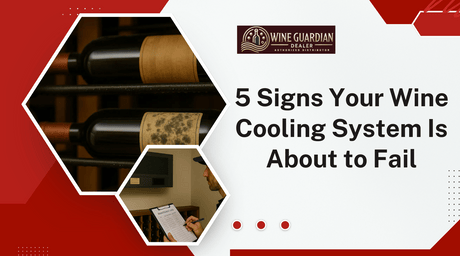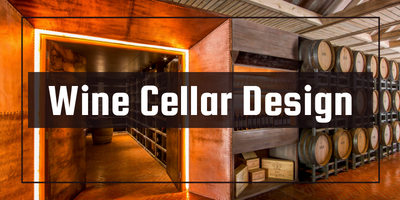
5 Signs Your Wine Cooling System Is About to Fail
Don’t wait for a costly surprise. Wine Guardian Dealer breaks down the top 5 signs your wine cooling system may be failing — and how to fix it before damage...
Jim Hopper
In Stock & Ready to Ship – Order Your Wine Cooling System Today!
Free Wine Cellar Expert Consultation | 📞 Call 1-800-260-1712
Start with a free expert consult—cooling system sizing, racking options, and no upsells.

Build your dream wine cellar—without costly mistakes or guesswork.
By Jim Hopper, Wine Cooling Expert
If you’ve spent time planning or building a wine cellar, you already know it’s more than just a stylish storage space — it’s an environment. And just like fine wine needs time, it also needs stability: consistent temperature, balanced humidity, and proper airflow.
Understanding the heat load is crucial for maintaining this stable environment, as it directly influences the choice of refrigeration unit needed to ensure the optimal temperature and humidity levels are achieved.
Enter the wine cellar cooling unit — the hero behind the scenes. And if you’re installing a Wine Guardian unit? You’re not just protecting your investment — you’re stepping into pro-level territory.
Whether you’re installing it yourself or just want to understand the process before calling in a contractor, this guide — built on insights from our full Wine Cellar Design and Installation: Build a Beautiful, Functional Wine Room That Lasts — is your go-to. We’ll walk through everything from prep and product selection to installation steps, common pitfalls, FAQs, and how to get support.

Before anything gets cut, mounted, or wired, you need to make sure your wine cellar is properly sealed. Cooling units don’t work magic — they regulate air, but they can’t overcome poor insulation or a leaky vapor barrier. Insulation should be at least R11 for interior walls and R19 for outer walls before installation. These units draw warm air from the wine cellar and either vent it outside or circulate it back through the cooling unit, ensuring consistent conditions crucial for proper wine storage.
R-Value Insulation
Vapor Barrier
Power Source
Drainage
Cooling units produce condensate. Plan a gravity-fed drain line or condensate pump for moisture management.
Ventilation or Duct Routing
Especially critical for ducted or split systems. You'll need access for intake and exhaust airflow.
Optional (for ducted/split systems):

Wine Guardian offers a full range of units — and choosing the right wine cellar cooling units and wine cellar refrigeration systems is more than just looking at room size. You’ll need to account for insulation, ambient temperatures, number of doors, and even glass.

A wine cellar cooling system is more than just an air conditioner; it’s a specialized unit designed to create the perfect environment for your wine collection. These systems are essential for preserving the quality, aroma, and taste of fine wines, ensuring they age gracefully and as intended.
At the heart of a wine cellar cooling system are three main components: the evaporator coil, the condenser coil, and the compressor. The evaporator coil works by removing heat from the air inside the cellar, while the condenser coil releases that heat outside. The compressor powers this cooling cycle, maintaining a consistent temperature and humidity level within the cellar.
Maintaining precise temperature and humidity control is crucial for the integrity of your wine. Too much fluctuation can spoil the wine, while the right conditions allow it to develop its full potential. Temperature fluctuations in a wine cellar should be minimal during a 24-hour period to avoid spoilage. Wine cellar cooling systems come in various configurations, including through-the-wall, freestanding, and as part of a larger system.
There are different types of wine cellar cooling systems to suit various needs:
Choosing the right cooling unit for your wine cellar depends on factors like the size of your cellar, insulation quality, and your specific requirements. By understanding the different types of systems and their features, you can select the best option to protect your wine collection.

Now let’s get into the good stuff: how to actually install a wine cooling system, step by step. We’ll focus on a Through-the-Wall Wine Guardian unit, then touch on additional steps for ducted and split systems.
Before doing anything permanent, open the box and check for:
Read the manual fully — seriously. Wine Guardian includes clear instructions tailored to each model.
💡 Pro tip: Add insulation around the sleeve to minimize vibration and sound transfer.
Check for:
For ducted systems, ensure that all ductwork is properly sealed and insulated to prevent any loss of cool air. Plan the airflow path carefully to maintain efficient operation. For split systems, the installation process involves more complexity. The condenser unit is typically placed outside or in a mechanical room, while the evaporator is installed inside the wine cellar. This setup requires precise refrigerant line connections and electrical wiring, which should be handled by a professional HVAC technician to ensure safety and efficiency.
Once installed, it's crucial to calibrate the unit to ensure it maintains the desired temperature and humidity levels. This may involve adjusting the thermostat settings and verifying the sensor readings. Regular monitoring of these conditions is essential to ensure the longevity and quality of your
Proper maintenance is key to ensuring your wine cellar cooling unit operates efficiently and effectively. Regular upkeep not only prevents breakdowns but also reduces energy costs and extends the lifespan of your unit.
It’s recommended to schedule annual maintenance with a qualified HVAC technician. They can inspect and clean your cooling unit, ensuring everything is in working order. Additionally, you should check and replace the air filters every 3-6 months to maintain optimal airflow and prevent dust buildup.
Monitoring the temperature and humidity levels in your wine cellar is crucial. These should always be within the optimal range for wine storage to preserve your collection. Regular cleaning of the cooling unit is also necessary to prevent dust and debris from accumulating on the coils and fans.
Don’t forget to check the condensate drain line regularly. Ensure it’s not clogged and is draining properly to avoid any water damage or mold growth.
By following these maintenance tips, you can help your wine cellar cooling unit operate at peak performance, providing the best conditions for your wine collection. Regular maintenance not only prevents costly repairs but also ensures your unit lasts longer. Wine storage experts recommend these practices to keep your cooling system running smoothly and your wine in perfect condition.
Whether you're going DIY or hiring a pro, installing the right cooling unit is the final step to creating a true wine cellar. And with Wine Guardian, you're not just getting performance — you're getting peace of mind.
👉 Explore cooling units, get sizing help, or connect with a pro installer today at WineGuardianDealer.com.
Got questions? Reach out — we’re here to help you protect your collection the right way.
Yes — unless your space naturally stays at 55–58°F with 60–70% humidity, a cooling unit is essential.
Yes, for through-the-wall or ducted self-contained units. Split systems require a professional.
TTW unit: 3–5 hours Ducted system: 1–2 days Split system: 1–3 days
55°F with 60–70% humidity for proper aging and cork preservation.
🛒Shop our most-loved Wine Guardian cooling systems today.
🛠️Protect your wine with the most trusted systems on the market.
❤️Tested, reviewed, and loved by serious collectors like you.